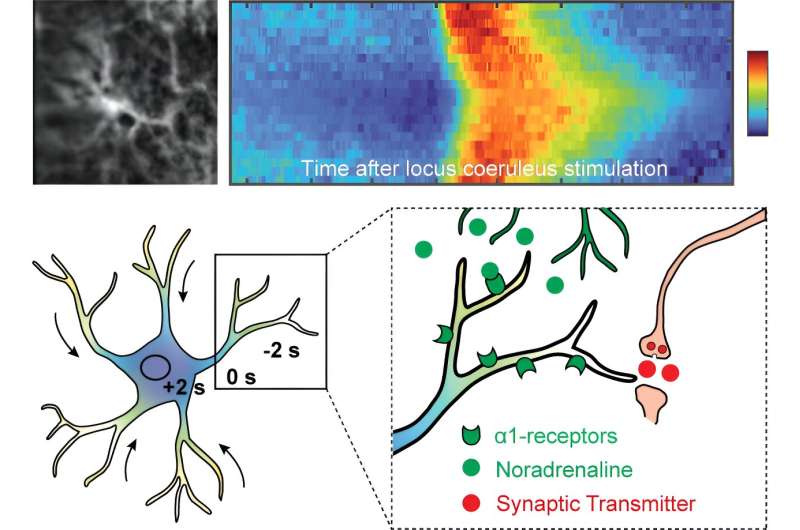Neurons are known to communicate and integrate information they receive from their dendrites, branch-like structures extending from their body. In contrast, the activity in astrocytes, a class of star-shaped glial cells found in the central nervous system (CNS), has so far been assumed to be largely uncoordinated, thus lacking the central integration of information.
Researchers at University of Zurich and ETH Zurich recently gathered evidence suggesting that this widespread description of astrocytes might be false or at least incomplete, as they do in fact integrate information about past events.
Their findings, published in Nature Neuroscience, specifically reveal the conditional integration of calcium signals in processes taking place in the astrocytes’ soma (i.e., cell body).
“Our research was originally aimed at testing a specific hypothesis about the function of astrocytes,” Fritjof Helmchen, co-author of the paper, told Medical Xpress. “During in-depth analysis of calcium imaging data, however, we made an unrelated and intriguing observation about calcium signals in astrocytes: We observed that calcium signals propagated from fine cellular processes to the soma on a timescale of seconds. This turned out to be a highly robust and fundamental effect.”
The results that Helmchen and his colleagues gathered in their experiments do not answer the research question they were originally trying to address. Nonetheless, they led to an unexpected observation that could open a new avenue for neuroscience research.
In contrast with neurons, astrocytes are not electrically excitable, which means that they do not generate and transmit electrical signals (i.e., action potentials). The only way to observe the activity of astrocytes is thus to image signaling molecules, such as calcium, inside of them.
“We performed two-photon imaging of calcium signals in the hippocampus of mice that were running on a treadmill and carefully analyzed the recordings,” Peter Rupprecht, co-author of the paper, told Medical Xpress. “Our main technique was therefore centered on pure observation and in-depth analysis.”

Helmchen, Rupprecht and their colleagues were only able to gather evidence of the integration of past events in astrocytes using advanced analysis methods based on so-called correlation functions. In their experiments, they also used optogenetics techniques to activate the locus coeruleus, a small nucleus in the brainstem that regulates arousal and attention processes.
“With these methods, we demonstrated that the astrocytic events are regulated by the neuromodulator noradrenaline,” Rupprecht said. “We hope that our study will encourage other astrocyte researchers to apply our methods and analysis techniques also to their research.”
This team of researchers was the first to systematically show how astrocytes slowly integrate information in their soma. Interestingly, the integration process they observed resembles the somatic integration that has been extensively documented in neurons.
“We also showed how this integration is regulated by arousal and the locus coeruleus, a small nucleus in the brain stem,” Rupprecht said. “We believe that this mode of information processing is very likely fundamental for the function of astrocytes as computational units in hippocampus and cortex.”
The findings gathered by Helmchen, Rupprecht and their collaborators could have profound research implications, as they suggest that astrocytes play a greater role than expected in the processing and integration of incoming signals. In the future, they could pave the way for more ground-breaking discoveries about the function of astrocytes in health and disease.
“In this study, we investigated how astrocytes integrate signals in their soma, but what do they do once their soma is activated and how do they act upon neurons?” Helmchen added. “We hypothesize that they contribute, in one or the other way, to information processing in the neuronal networks. Our study raises many questions that will require the joint effort of many labs in the future.”
More information:
Peter Rupprecht et al, Centripetal integration of past events in hippocampal astrocytes regulated by locus coeruleus, Nature Neuroscience (2024). DOI: 10.1038/s41593-024-01612-8
© 2024 Science X Network
Citation:
Study shows that astrocytes integrate information about past events in their soma (2024, May 9)
retrieved 9 May 2024
from https://medicalxpress.com/news/2024-05-astrocytes-events-soma.html
This document is subject to copyright. Apart from any fair dealing for the purpose of private study or research, no
part may be reproduced without the written permission. The content is provided for information purposes only.

